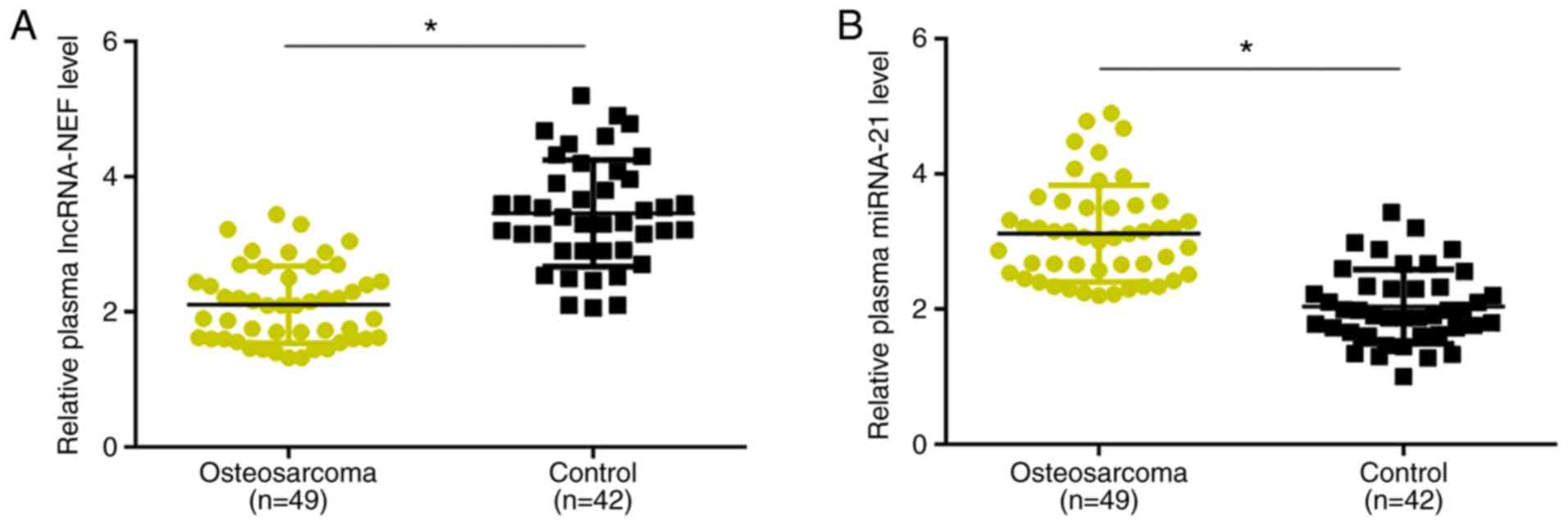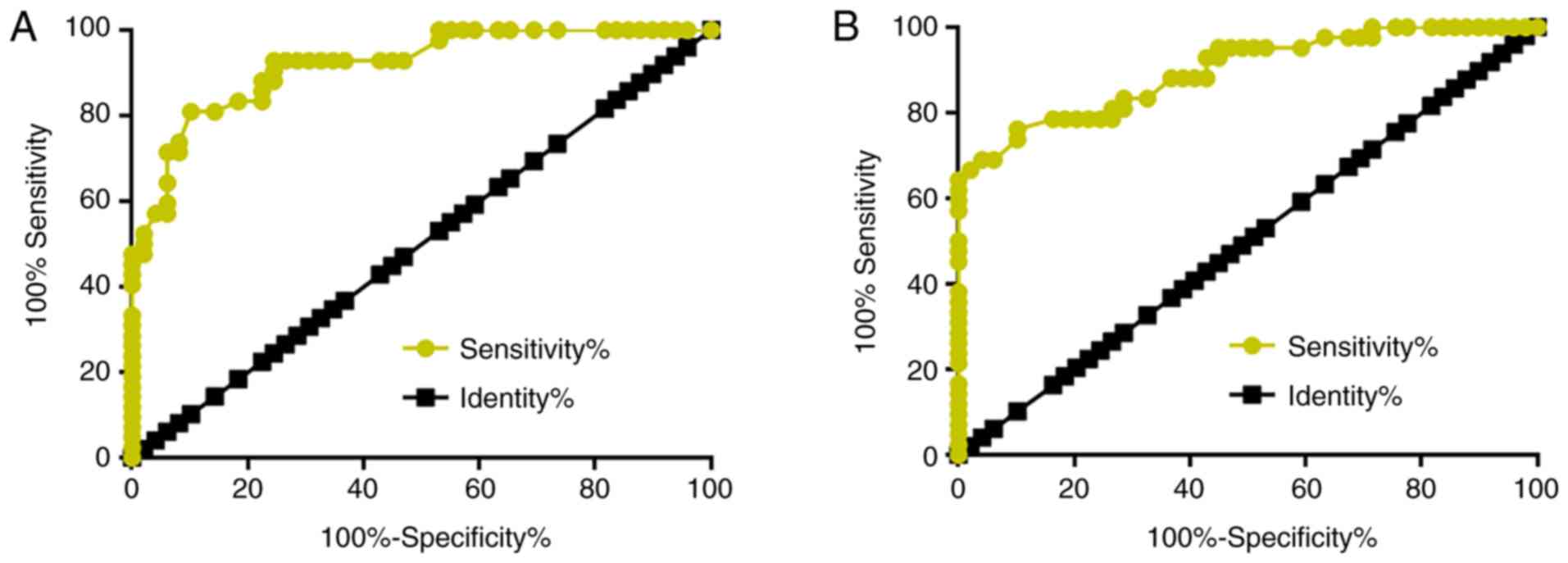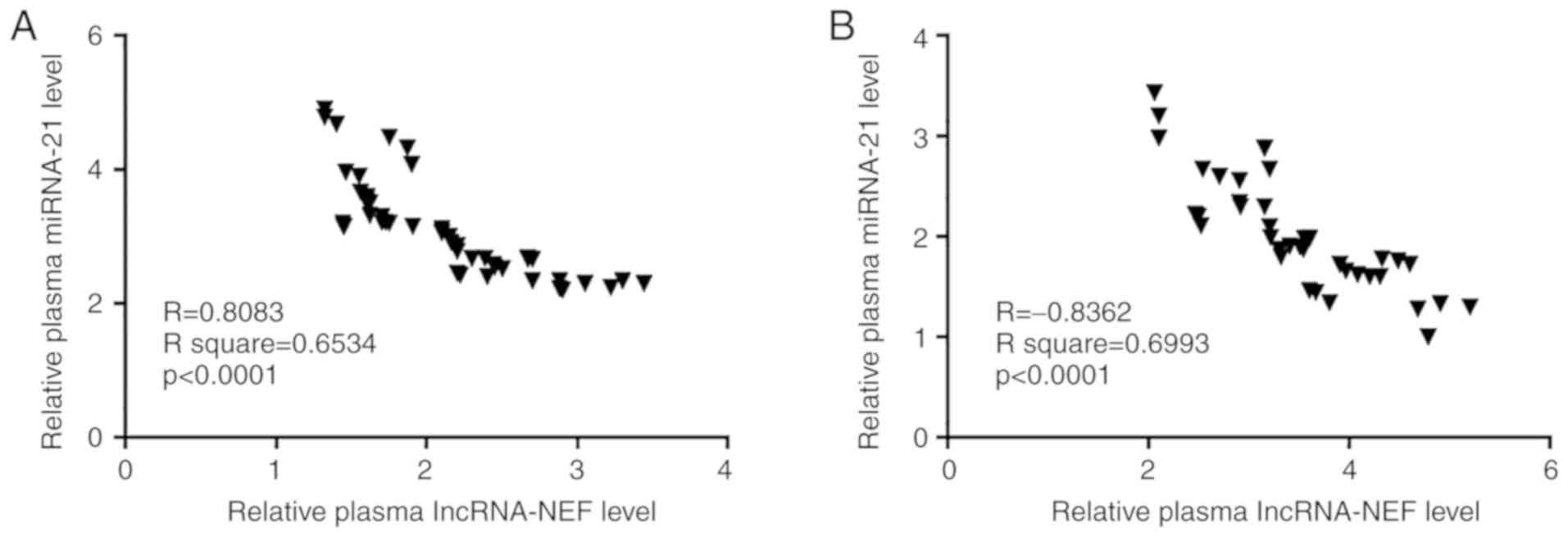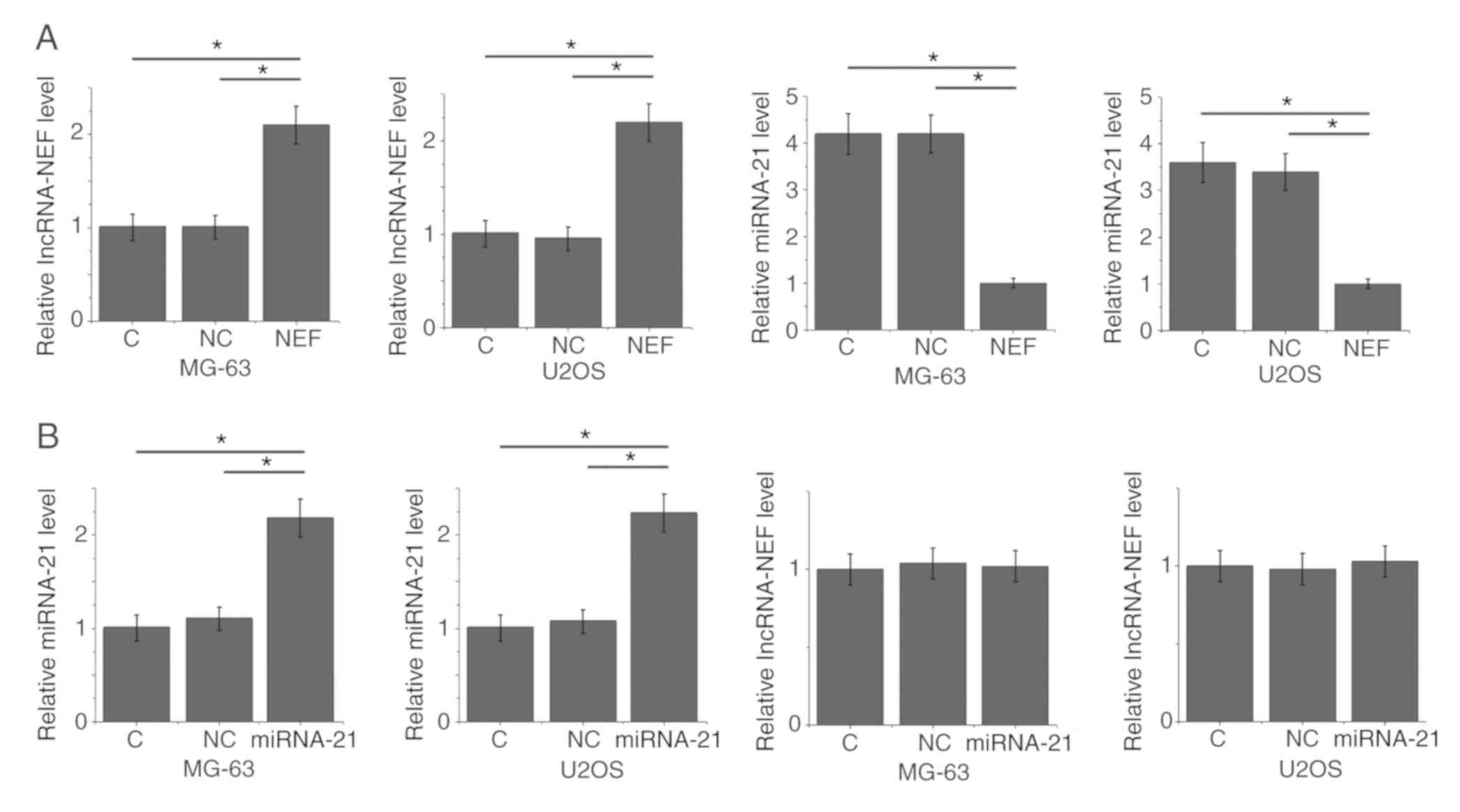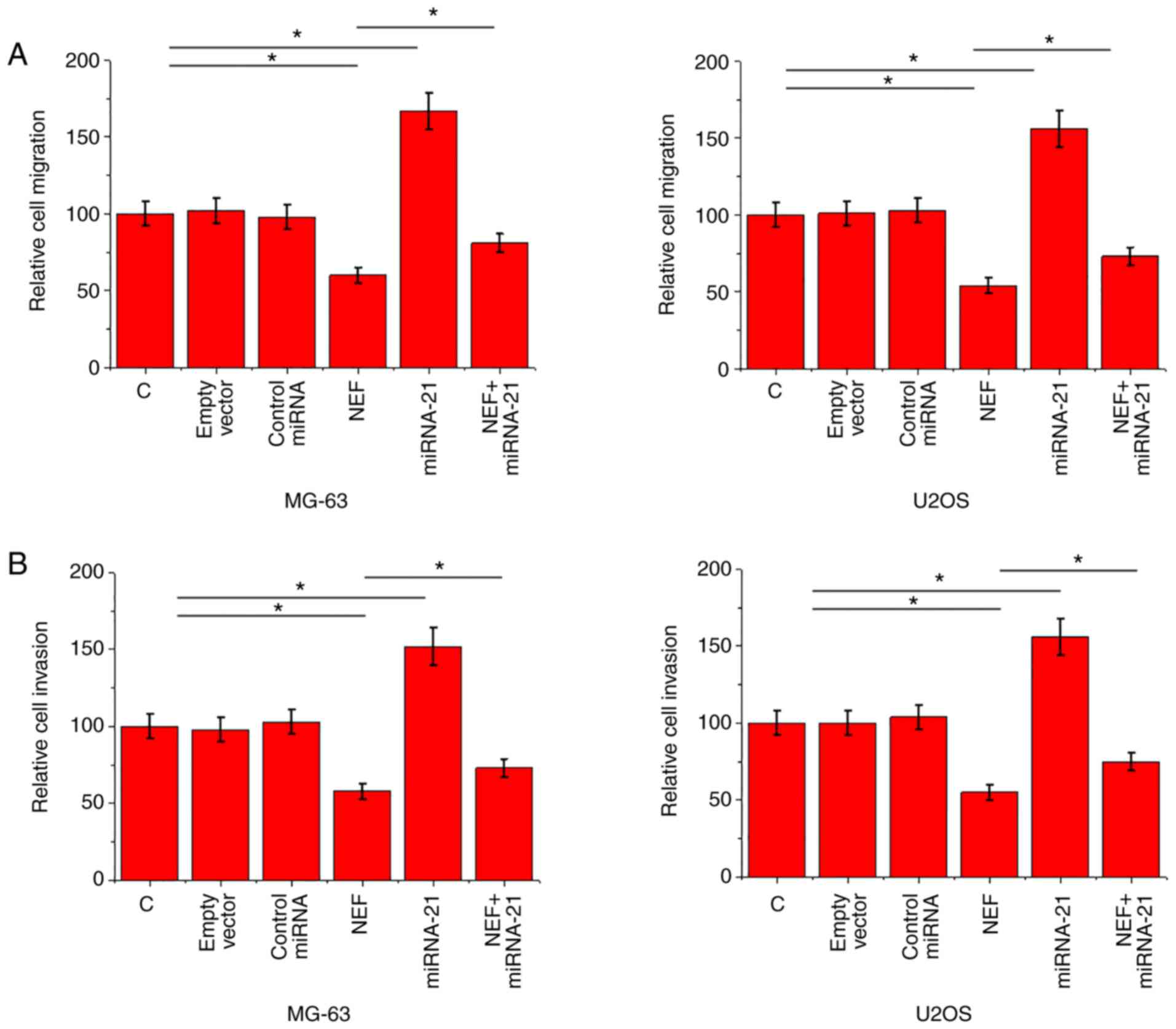Introduction
Osteosarcoma is a rare type of malignancy which
originates in bone and affects ~5 in 1,000,000 patients (1). In spite of the low incidence,
osteosarcoma has a high mortality rate due to the high prevalence
rate of metastases by the time of first diagnosis (2). Improved treatment strategies have
increased the survival time of patients with osteosarcoma (3,4).
However, the overall five-year survival rate of patients with this
disease remains ~30% (5). The
mechanisms underlying the pathogenesis of osteosarcoma have not
been fully elucidated, potentially hindering the development of
novel treatment strategies for this disease (6). Therefore, in-depth studies on the
molecular mechanisms involved in osteosarcoma may improve its
treatment.
In addition to protein-coding genes, the human
genome contains a large number of genes which are transcribed to
non-coding RNAs, including microRNAs (miRNAs) and long non-coding
RNAs (lncRNAs) (7,8). miRNAs and lncRNAs participate in the
regulation of cell growth, proliferation, differentiation,
migration and invasion by interacting with a number of signaling
pathways (7,8). Previous studies have revealed that
non-coding RNAs serve key roles in a number of human diseases,
including metabolic diseases, heart diseases and cancer (9,10). As an
oncogenic miRNA, miRNA-21 promotes tumor development in different
types of cancer, including osteosarcoma (11). miRNA-21 may participate in
tumorigenesis through interactions with lncRNA (12). lncRNA neighboring enhancer of FOXA2
(lncRNA-NEF) is a recently identified tumor suppressor lncRNA which
is involved in hepatocellular carcinoma (13). To the best of our knowledge, no
studies investigating the interaction between lncRNA-NEF and miRNAs
have been reported. The present study revealed that lncRNA-NEF may
inhibit cancer cell migration and invasion in osteosarcoma by
downregulating miRNA-21.
Materials and methods
Plasma specimens
Blood specimens (5 ml) were collected from 49
patients with osteosarcoma and 42 healthy volunteers who were
admitted to Guangzhou General Hospital of Guangzhou Military
Command (Guangzhou, China) between September 2015 and June 2018.
Blood was placed in anticoagulation tubes and centrifuged at room
temperature for 15 min at 2,000 × g to collect the plasma. The
inclusion criteria of patients with osteosarcoma were as follows:
i) Osteosarcoma was diagnosed by pathological examinations; ii)
osteosarcoma stage I or II; iii) patients who were diagnosed and
treated for the first time; and iv) patients who were willing to
participate in the study. The exclusion criteria were as follows:
i) Presence of co-morbidities; and ii) patients who were treated
for other clinical disorders in the three months prior to
admission. The patient group included 26 males and 23 females, with
an age range of 12–33 years and a mean age of 19.3±4.2 years. The
control group was composed of 23 males and 19 females, with an age
range of 13–30 years and a mean age of 18.8±4.7 years. The two
groups had similar gender and age distributions. Ethical approval
was obtained from the Ethics Committee of Guangzhou General
Hospital of Guangzhou Military Command. The study followed the
tenets of the Declaration of Helsinki, and written informed consent
was obtained from all patients and controls after the nature and
possible consequences of the study were explained.
Cell culture
The human osteosarcoma cell lines MG-63 and U2OS
were used in the current study. The two cell lines were purchased
from the American Type Culture Collection (ATCC; Manassas, VA,
USA). Eagle's Minimum Essential Medium (cat no. 30-2003; ATCC)
supplemented with 10% heat-inactivated fetal bovine serum (FBS;
Sangon Biotech Co., Ltd., Shanghai, China) was used to cultivate
cells in an incubator (37°C, 5% CO2).
Reverse transcription-quantitative
polymerase chain reaction (RT-qPCR)
Total RNA was extracted from plasma and cells using
TRIzol® reagent (Invitrogen; Thermo Fisher Scientific,
Inc., Waltham, MA, USA) and miRNAs were extracted from plasma and
cells using the miRNeasy Mini kit (Qiagen GmBH, Hilden, Germany),
according to the manufacturer's protocol. An Applied Biosystems™
High-Capacity cDNA Reverse Transcription kit (Applied Biosystems;
Thermo Fisher Scientific, Inc.) and a miScript II RT kit (Qiagen
GmBH) were used for reverse transcription. qScript One-Step RT-qPCR
kit (Quanta Bisciences, Inc., Beverly, MA, USA) and mirVana qRT-PCR
miRNA Detection kit (Thermo Fisher Scientific, Inc.) were used to
perform qPCR reactions in an ABI 7500 System (Applied Biosystems;
Theremo Fisher Scientific Inc.). The miRNA-21 primer pair was
purchased from Sigma-Aldrich (cat. no. MIRAP00047; Merck KGaA,
Darmstadt, Germany). The following primer pairs and the miRNA-21
primers were used for the qPCR: lncRNA-NEF forward,
5′-CTGCCGTCTTAAACCAACCC-3′ and reverse, 5′-GCCCAAACAGCTCCTCAATT-3′;
β-actin forward, 5′-GACCTCTATGCCAACACAGT-3′ and reverse,
5′-AGTACTTGCGCTCAGGAGGA-3′; U6 forward, 5′-CTCGCTTCGGCAGCACA3′ and
reverse, 5′-AACGCTTCACGAATTTGCGT-3′. The aforementioned primers
were designed and synthesized by Shangai GenePharma Co., Ltd.
(Shanghai, China). The following thermocycling conditions were used
for the qPCR: Initial denaturation at 95°C for 55 sec, 40 cycles of
95°C for 22 sec and 60°C for 44 sec. mRNA levels were quantified
using the 2−ΔΔCq method (14). miRNA-21 expression was normalized to
U6, while lncRNA-NEF was normalized to β-actin.
Vectors, miRNAs and cell
transfection
MISSION® microRNA Mimic hsa-miR-21* (cat
no. HMI0372) and MISSION® miRNA, Negative Control 1 (cat
no. HM0002) were purchased from Sigma-Aldrich; Merck KGaA.
lncRNA-NEF expression pIRES vectors and empty pIRES vectors were
purchased from Shanghai GenePharma Co., Ltd. lncRNA-NEF sequence
refers to a previous study (13).
Lipofectamine® 2000 (Invitrogen; Thermo Fisher
Scientific, Inc.) was used to transfect 5×105 cells with
miRNA (50 mM) and vectors (15 mM). Transfection was performed
according to the manufacturer's protocol. Untransfected cells were
used as control (C) cells. Cells transfected with
MISSION® miRNA, Negative Control 1 or empty vectors were
used as negative control (NC) cells. Transfection efficacy was
determined by RT-qPCR. Cells were harvested 24 h following
transfection for subsequent experimentation.
Transwell migration and invasion
assay
Cell migration and invasion were quantified when
lncRNA-NEF and miRNA overexpression rates reached 200–250%
following 24 h transfection. Cultrex® 96-well cell
migration/invasion chambers (8 µm) were purchased from Bio-Techne
(Minneapolis, MN, USA). The assays were performed according to
manufacturer's protocol. Briefly, serum-free Eagle's Minimum
Essential Medium was used to prepare single cell suspensions
(5×104 cells/ml). A total of 5×103 cells in
100 µl were transferred to the upper chamber of each well, and the
lower chamber was filled with Eagle's Minimum Essential Medium
supplemented with 20 % FBS. Cells were maintained in an incubator
(37°C, 5% CO2) for 2 h. Membranes were subsequently
stained with 0.5% crystal violet (Sigma-Aldrich; Merck KGaA) at
25°C for 20 min. The invasion assay was performed in the same way
as the migration assay; however, the upper chamber was pre-coated
with Matrigel (cat no. 356234; Millipore; Merck KGaA) at room
temperature for 6 h prior to experimentation.
Statistical analysis
All experiments were repeated three times and data
are presented as the mean ± standard deviation. All statistical
analyses were performed using GraphPad Prism 6 software (GraphPad
Software Inc., La Jolla, CA, USA). Correlations between plasma
lncRNA-NEF and miRNA-21 were analyzed by Pearson's correlation
test. Receiver operating characteristic (ROC) curve analysis was
performed using patients with osteosarcoma as true positive cases
and healthy controls as true negative cases. Comparisons between
two groups were performed using the Student's t-test and
comparisons among multiple groups were performed by a one-way
analysis of variance followed by the Tukey test. P<0.05 was
considered to indicate a statistically significant difference.
Results
Plasma levels of lncRNA-NEF and
miRNA-21 are altered in patients with osteosarcoma compared with
healthy controls
RT-qPCR results revealed that, compared with the
healthy control group, plasma levels of lncRNA-NEF were
significantly decreased in patients with osteosarcoma (P<0.05;
Fig. 1A). By contrast, plasma levels
of miRNA-21 were significantly increased in patients with
osteosarcoma compared with healthy controls (P<0.05; Fig. 1B). These data suggest that lncRNA-NEF
and miRNA-21 may be implicated in osteosarcoma.
Altered plasma levels of lncRNA-NEF
and miRNA-21 distinguish patients with osteosarcoma from healthy
controls
To evaluate the diagnostic value of lncRNA-NEF and
miRNA-21 for osteosarcoma, ROC curve analysis was performed with
patients with osteosarcoma as true positive cases and healthy
controls as true negative cases. For plasma lncRNA-NEF, the area
under the curve (AUC) was 0.9176, with a standard error of 0.02793
and 95% confidence interval (CI) of 0.8629–0.9724 (Fig. 2A). For plasma miRNA-21, the AUC was
0.9009, with a standard error of 0.02863 and 95% CI of
0.8457–0.9662 (Fig. 2B).
Plasma lncRNA-NEF and miRNA-21 are
significantly and reversely correlated in both patients with
osteosarcoma and healthy controls
Correlations between plasma lncRNA-NEF and miRNA-21
in patients with osteosarcoma and healthy controls were analyzed by
the Pearson's correlation test. Results revealed that plasma levels
of lncRNA-NEF and miRNA-21 were significantly and reversely
correlated in patients with osteosarcoma (P<0.05; Fig. 3A). In addition, a significantly
reverse correlation between plasma levels of lncRNA-NEF and
miRNA-21 was demonstrated in healthy controls (P<0.05; Fig. 3B).
lncRNA-NEF overexpression leads to
inhibited miRNA-21 expression in two human osteosarcoma cell
lines
The reverse correlation between plasma lncRNA-NEF
and miRNA-21 suggests the possibility of interactions between them.
To further explore these potential interactions, lncRNA-NEF
expression vectors and miRNA-21 mimics were transfected into the
human osteosarcoma cell lines MG-63 and U2OS. lncRNA-NEF and
miRNA-21 expression was subsequently detected using RT-qPCR
(Fig. 4). Compared with the C and NC
groups, lncRNA-NEF overexpression significantly decreased
expression of miRNA-21 in the two cell lines (P<0.05; Fig. 4A). By contrast, miRNA-21
overexpression resulted in no significant effects on the expression
of lncRNA-NEF (P<0.05; Fig.
4B).
lncRNA-NEF overexpression inhibits
migration of osteosarcoma cells, possibly through miRNA-21
Transwell migration and invasion assays were
performed to investigate the effects of lncRNA-NEF and miRNA-21
overexpression on the migration and invasion abilities of MG-63 and
U2OS human osteosarcoma cell lines. Compared with the C, control
miRNA and empty vector groups, lncRNA-NEF overexpression
significantly inhibited and miRNA-21 overexpression significantly
promoted migration (P<0.05; Fig.
5A) and invasion (P<0.05; Fig.
5B) of MG-63 and U2OS human osteosarcoma cell lines. Compared
with cells with lncRNA-NEF overexpression alone, cells with
lncRNA-NEF and miRNA-21 overexpression exhibited significantly
reduced migration (P<0.05; Fig.
5A) and invasion (P<0.05; Fig.
5B) abilities.
Discussion
lncRNA-NEF is an oncogenic lncRNA which may inhibit
epithelial to mesenchymal transition in hepatocellular carcinoma
(13); however, its involvement in
other human diseases is unknown. The present study revealed that
lncRNA-NEF may inhibit cancer cell migration and invasion in
osteosarcoma. These effects may be mediated by the downregulation
of miRNA-21, a well-characterized oncogenic miRNA in cancer biology
(11).
Treatment of osteosarcoma is challenged by the high
prevalence rate of tumor metastasis by the time of diagnosis
(2). Therefore, early diagnosis is
required to improve patient outcomes. The current study enrolled
patients with stage I and II osteosarcoma, which are early stages
of osteosarcoma. Downregulation of lncRNA-NEF was previously
observed in patients with hepatocellular carcinoma (13). The present study revealed
significantly decreased plasma levels of lncRNA-NEF in patients
with osteosarcoma compared with healthy controls. Downregulation of
plasma lncRNA-NEF effectively distinguished patients with
osteosarcoma from healthy controls, indicating that decreased
levels of plasma lncRNA-NEF may have diagnostic value in the early
detection of osteosarcoma. Subsequent in vitro experiments
revealed that lncRNA-NEF may promote cancer cell invasion and
migration in osteosarcoma. Therefore, the downregulation of
lncRNA-NEF in patients with osteosarcoma may be used to predict
tumor metastasis. lncRNA-NEF may serve as a therapeutic target for
the prevention of tumor metastasis in osteosarcoma.
As an oncogenic miRNA, miRNA-21 is upregulated in
different types of human malignancies, including osteosarcoma
(15–17). Consistent with previous studies, the
current study observed significantly upregulated plasma miRNA-21 in
patients with osteosarcoma compared with healthy controls.
Overexpression of miRNA-21 distinguished patients with osteosarcoma
from healthy controls. However, altered expression of miRNA-21 has
been observed in different types of cancer (11,15–17).
Therefore, the diagnostic specificity of plasma miRNA-21 for
osteosarcoma may be low.
The present study demonstrated a reverse correlation
between plasma miRNA-21 and lncRNA-NEF in both patients with
osteosarcoma and healthy controls. In vitro experiments
using osteosarcoma cell lines revealed that lncRNA-NEF is a
potential upstream inhibitor of miRNA-21 in the regulation of
migration and invasion of osteosarcoma cells. lncRNA-NEF
overexpression failed to significantly affect osteosarcoma cell
proliferation (data not shown, revealed by Cell Counting Kit-8
assay). miRNA-21 has been previously reported to be involved in the
regulation of cancer proliferation in osteosarcoma (17–19).
Therefore, lncRNA-NEF may antagonize the effects of downregulation
of miRNA-21 on cancer cell proliferation. The current study
reported that lncRNA-NEF may interact with a miRNA to participate
in cancer development.
In conclusion, lncRNA-NEF is downregulated and miRNA
is upregulated in patients with osteosarcoma compared with healthy
controls. lncRNA-NEF may inhibit cancer cell migration and invasion
in osteosarcoma by downregulating miRNA-21.
Acknowledgements
Not applicable.
Funding
No funding was received.
Availability of data and materials
The datasets used and/or analyzed during the present
study are available from the corresponding author on reasonable
request.
Authors' contributions
QLY, HY, XH, QSY and CZ performed the experiments.
QLY analyzed the data and was a major contributor in writing the
manuscript. All authors read and approved the final manuscript.
Ethics approval and consent to
participate
Ethical approval was obtained from the Ethics
Committee of Guangzhou General Hospital of Guangzhou Military
Command. The study followed the tenets of the Declaration of
Helsinki, and written informed consent was obtained from all
patients and controls after the nature and possible consequences of
the study were explained.
Patient consent for publication
Not applicable.
Competing interests
The authors declare that they have no competing
interests.
References
|
1
|
Ottaviani G and Jaffe N: The epidemiology
of osteosarcoma. Cancer Treat Res. 152:3–13. 2009. View Article : Google Scholar : PubMed/NCBI
|
|
2
|
Marko TA, Diessner BJ and Spector LG:
Prevalence of metastasis at diagnosis of osteosarcoma: An
international comparison. Pediatr Blood Cancer. 63:1006–1011. 2016.
View Article : Google Scholar : PubMed/NCBI
|
|
3
|
Luetke A, Meyers PA, Lewis I and Juergens
H: Osteosarcoma treatment-where do we stand? A state of the art
review. Cancer Treat Rev. 40:523–532. 2014. View Article : Google Scholar : PubMed/NCBI
|
|
4
|
Li JZ, Tian ZQ, Jiang SN and Feng T:
Effect of variation of ABCB1 and GSTP1 on osteosarcoma survival
after chemotherapy. Genet Mol Res. 13:3186–3192. 2014. View Article : Google Scholar : PubMed/NCBI
|
|
5
|
Anderson ME: Update on survival in
osteosarcoma. Orthop Clin North Am. 47:283–292. 2016. View Article : Google Scholar : PubMed/NCBI
|
|
6
|
Denduluri SK, Wang Z, Yan Z, Wang J, Wei
Q, Mohammed MK, Haydon RC, Luu HH and He TC: Molecular pathogenesis
and therapeutic strategies of human osteosarcoma. J Biomed Res.
30:2015.PubMed/NCBI
|
|
7
|
Mattick JS and Makunin IV: Non-coding RNA.
Hum Mol Genet. 15:R17–R29. 2006. View Article : Google Scholar : PubMed/NCBI
|
|
8
|
Eddy SR: Non-coding RNA genes and the
modern RNA world. Nat Rev Genet. 2:919–929. 2001. View Article : Google Scholar : PubMed/NCBI
|
|
9
|
Esteller M: Non-coding RNAs in human
disease. Nat Rev Genet. 12:861–874. 2011. View Article : Google Scholar : PubMed/NCBI
|
|
10
|
Taft RJ, Pang KC, Mercer TR, Dinger M and
Mattick JS: Non-coding RNAs: Regulators of disease. J Pathol.
220:126–139. 2010. View Article : Google Scholar : PubMed/NCBI
|
|
11
|
Kumarswamy R, Volkmann I and Thum T:
Regulation and function of miRNA-21 in health and disease. RNA
Biol. 8:706–713. 2011. View Article : Google Scholar : PubMed/NCBI
|
|
12
|
Dan J, Wang J, Wang Y, Zhu M, Yang X, Peng
Z, Jiang H and Chen L: LncRNA-MEG3 inhibits proliferation and
metastasis by regulating miRNA-21 in gastric cancer. Biomed
Pharmacother. 99:931–938. 2018. View Article : Google Scholar : PubMed/NCBI
|
|
13
|
Liang WC, Ren JL, Wong CW, Chan SO, Waye
MM, Fu WM and Zhang JF: LncRNA-NEF antagonized epithelial to
mesenchymal transition and cancer metastasis via cis-regulating
FOXA2 and inactivating Wnt/beta-catenin signaling. Oncogene.
37:1445–1456. 2018. View Article : Google Scholar : PubMed/NCBI
|
|
14
|
Livak KJ and Schmittgen TD: Analysis of
relative gene expression data using real-time quantitative PCR and
the 2(-Delta Delta C(T)) method. Methods. 25:402–408. 2001.
View Article : Google Scholar : PubMed/NCBI
|
|
15
|
Han Y, Xu GX, Lu H, Yu DH, Ren Y, Wang L,
Huang XH, Hou WJ, Wei ZH, Chen YP, et al: Dysregulation of miRNA-21
and their potential as biomarkers for the diagnosis of cervical
cancer. Int J Clin Exp Pathol. 8:7131–7139. 2015.PubMed/NCBI
|
|
16
|
Costa PM, Cardoso AL, Custodia C, Cunha P,
Pereira de Almeida L and Pedroso de Lima MC: MiRNA-21 silencing
mediated by tumor-targeted nanoparticles combined with sunitinib: A
new multimodal gene therapy approach for glioblastoma. J Control
Release. 207:31–39. 2015. View Article : Google Scholar : PubMed/NCBI
|
|
17
|
Zhang QL, Yang SH, Liu HY and Wu CH:
Nhibition of osteosarcoma cell proliferation by a short hairpin RNA
targeting proliferation cell nuclear antigen. Zhonghua Bing Li Xue
Za Zhi. 34:167–170. 2005.(In Chinese). PubMed/NCBI
|
|
18
|
Li C, Xu B, Miu X, Deng Z, Liao H and Hao
L: Inhibition of miRNA-21 attenuates the proliferation and
metastasis of human osteosarcoma by upregulating PTEN. Exp Ther
Med. 15:1036–1040. 2018.PubMed/NCBI
|
|
19
|
Zhao J, Zhang C, Gao Z, Wu H, Gu R and
Jiang R: Long non-coding RNA ASBEL promotes osteosarcoma cell
proliferation, migration, and invasion by regulating microRNA-21. J
Cell Biochem. 119:6461–6469. 2018. View Article : Google Scholar : PubMed/NCBI
|















